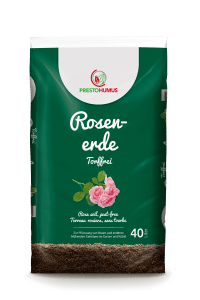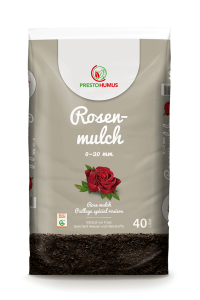Its title originates from both, the beauty of its blossoms as well as from the location required and care needed. The beauty of the blossoms – whether filled or simple ones – is reflected in many interesting and attractive plays of colours. In general, roses have a significant species diversity and a long-lasting flowering period during the season. Creation, planting and care of a colourful rose bed are much easier than many hobby gardeners dare to believe.
The rose – The garden queen
How to: easy-care rose bed
Complying with the demand for the ideal location is easier than you might think:
Roses like a sunny to half-shaded, airy location, preferring east or west side. Heat protection is useful on very hot and sunny days.
– prepare the garden soil accordingly, i.e. aerating by using spade and rake
– A humous and deep loamy ground is the ideal one. Slightly sandy soils can be improved by adding bark humus, whereas heavy clay grounds can be broken up with sand and compost.
– The planting hole has to be deep.
– Roses are in the need of enough space, the following plant distances are recommended:
– 30 cm for miniature roses
– 40 – 50 cm bed & floribunda roses
– 50 – 80 cm for ground cover roses
– 100 – 150 cm for rambler & shrub roses
– Plant the roses, make sure that the roots are completely covered with soil, if necessary add some more soil.
– Press the soil by hand thoroughly, but gently and water sufficiently.
As weather protection the planting area should be covered with rose mulch, this prevents the soil from rapid drying and activates soil organisms, which results in a healthy growth of the roses.
The right companion for your rose bed
It is advisable to consider the fitting neighbouring plants. Moss phlox and flowering quince shrubs bloom with lush blossoms already in spring time, so doe cranesbills and bellflowers.
Take asters for plantings during autumn season. As all-season species foxglove, larkspur or lilies are recommended.
If you are looking for an attractive and indeciduous composition for an easy-care rose bed you should decide to go for shrubs such as box trees and holly, bergenia and coral bells – so bleak and leafless plants or bushes are off the cards and not a problem during winter time.
Those, who put little emphasis on too much effort on caring for rose beds, should decide on dwarf pine tree or thuja, as those trees need less pruning and trimming.
… in spring
Annually, right before the leaf shoot, take a sharp pair of rose pruners in order to cut back the week and dead shoots, down to healthy wood parts. When pruning the roses leave 3-5 shoots with at least 5 eyes.
… in summer
Deadhead the roses (buds and dead heads) and prune to 5-part leaf. Remove wild shoots (7-part leaves) from the rhizome.
… in autumn
Depending on the weather in November cut all shoots by 1/3. As preventative measure for cold winter days: Earth up the plants with rose mulch – no peat!
Cutting guide
Use a sharp rose pruner for a clean cut. Make a bevel cut, approx. ½ cm above an outward eye.
Container roses can be planted year-round except in the frosty season.
Before planting, immerse the pot in a water bath until no more air bubbles rise.
The planting hole slightly larger (about 50%) than lifting the container and loosen up the soil, possibly with bark humus, compost or sand improve. Place the rose in the planting hole so that the finishing point is approx. 5-8 cm below the soil surface. Fill the planting hole with soil, set the soil well and create a casting trough. Then water abundantly.
Product recommendations for the rose bed




